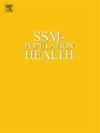The impact of slow mobility and built environment characteristics on 12.5-year all-cause mortality among older women and men: A prospective cohort study from Poland
IF 3.1
2区 医学
Q1 PUBLIC, ENVIRONMENTAL & OCCUPATIONAL HEALTH
引用次数: 0
Abstract
Worldwide initiatives promoting mobility modes such as walking or cycling as low-cost and zero-emission forms of transport, have highlighted the possible health benefits of slow mobility. Identifying crucial elements of the built environment (BE) for slow mobility users, especially older adults, is important.
The study aimed to: compare the mortality risk of slow mode users with other transport mode users in both men and women; verify, which aspects of subjective and objective assessment of the BE are relevant as risk factors of 12.5-year all-cause mortality across various mobility mode users; examine social participation as a mediator of the relationship.
The Polish part of the COURAGE in Europe cross-sectional baseline study was conducted in 2011. The analysis included 1166 face-to-face interviews with randomly selected community-dwelling individuals aged 65 years or older from Poland. Information about deaths was obtained from the State Systems Department on Mar 1, 2024. The outdoor BE was assessed by trained interviewers’ direct observations. The Cox proportional hazard models were used.
Higher quality of streetscapes (in women) and walkways (in men) for those who mainly walk in their neighborhood, and bikeways (in women who cycle) were found to be significant protective factors against mortality. Walkways and bikeways were associated with a higher risk of death in the fast mode of transportation group of men. Mediation effect of social participation was found in unadjusted models.
The findings underline the importance of planning and organizing the BE from an age–friendly perspective and the need for a holistic approach to urban planning.
慢流动性和建筑环境特征对老年男女12.5年全因死亡率的影响:来自波兰的一项前瞻性队列研究
促进步行或骑自行车等低成本和零排放的交通方式的全球倡议强调了缓慢移动可能带来的健康益处。为行动缓慢的使用者(尤其是老年人)确定建筑环境的关键要素是很重要的。该研究的目的是:比较男性和女性慢速模式使用者与其他交通方式使用者的死亡风险;验证不同出行方式使用者12.5年全因死亡率的主观和客观评估的哪些方面是相关的风险因素;考察社会参与作为关系的中介。欧洲COURAGE横断面基线研究的波兰部分于2011年进行。分析包括1166个面对面访谈,随机选择来自波兰的65岁或以上的社区居民。有关死亡的信息于2024年3月1日从州系统部门获得。户外BE由训练有素的采访者直接观察评估。采用Cox比例风险模型。研究发现,对于那些主要在社区步行的人来说,较高质量的街景(女性)和人行道(男性)以及自行车道(骑自行车的女性)是降低死亡率的重要保护因素。在使用快速交通工具的人群中,人行道和自行车道与更高的死亡风险相关。在未调整的模型中发现了社会参与的中介效应。研究结果强调了从老年人友好的角度规划和组织BE的重要性,以及对城市规划采取整体方法的必要性。
本文章由计算机程序翻译,如有差异,请以英文原文为准。
求助全文
约1分钟内获得全文
求助全文
来源期刊

Ssm-Population Health
PUBLIC, ENVIRONMENTAL & OCCUPATIONAL HEALTH-
CiteScore
6.50
自引率
2.10%
发文量
298
审稿时长
101 days
期刊介绍:
SSM - Population Health. The new online only, open access, peer reviewed journal in all areas relating Social Science research to population health. SSM - Population Health shares the same Editors-in Chief and general approach to manuscripts as its sister journal, Social Science & Medicine. The journal takes a broad approach to the field especially welcoming interdisciplinary papers from across the Social Sciences and allied areas. SSM - Population Health offers an alternative outlet for work which might not be considered, or is classed as ''out of scope'' elsewhere, and prioritizes fast peer review and publication to the benefit of authors and readers. The journal welcomes all types of paper from traditional primary research articles, replication studies, short communications, methodological studies, instrument validation, opinion pieces, literature reviews, etc. SSM - Population Health also offers the opportunity to publish special issues or sections to reflect current interest and research in topical or developing areas. The journal fully supports authors wanting to present their research in an innovative fashion though the use of multimedia formats.
 求助内容:
求助内容: 应助结果提醒方式:
应助结果提醒方式:


